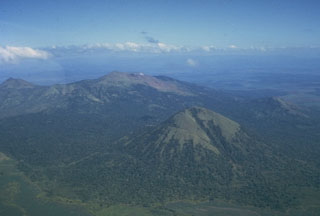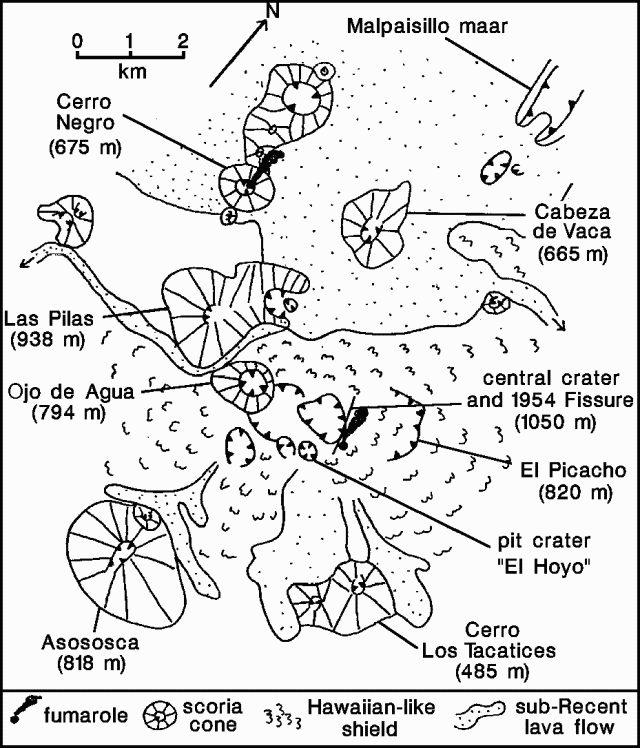Report on Las Pilas-El Hoyo Complex (Nicaragua) — February 1991
Bulletin of the Global Volcanism Network, vol. 16, no. 2 (February 1991)
Managing Editor: Lindsay McClelland.
Las Pilas-El Hoyo Complex (Nicaragua) Continued fumarolic activity; many young prehistoric lava flows
Please cite this report as:
Global Volcanism Program, 1991. Report on Las Pilas-El Hoyo Complex (Nicaragua) (McClelland, L., ed.). Bulletin of the Global Volcanism Network, 16:2. Smithsonian Institution. https://doi.org/10.5479/si.GVP.BGVN199102-344080
Las Pilas-El Hoyo Complex
Nicaragua
12.4922°N, 86.6786°W; summit elev. 1088 m
All times are local (unless otherwise noted)
"The El Hoyo fumarole was visited 3 times (15:04) and showed no discernable change from wet- to dry-season conditions (98°C). There is no other strong thermal activity in the summit region of El Hoyo.
"The central crater walls of El Hoyo (150 m deep) are composed of lava and agglutinated spatter, probably produced by Hawaiian activity (figure 1). In contrast, Las Pilas, Asososca, and Cerro Negro are predominantly scoria cones formed by Strombolian eruptions. All vents have produced extensive lava flows. Poorly vegetated flows extend up to 15 km from both Las Pilas and El Hoyo and are probably less than a few thousand years old."
Reference. Bice, D.C., 1980, Tephra stratigraphy and physical aspects of recent volcanism near Managua, Nicaragua: Ph.D. Dissertation, Univ of California, Berkeley, 422 p.
Geological Summary. Las Pilas-El Hoyo volcanic complex, overlooking Cerro Negro volcano to the NW, includes a diverse cluster of cones within about a 3-km-diameter area. A N-S-trending fracture system cutting across the edifice is marked by numerous flank vents, including maars, that are part of a 30-km-long volcanic massif. The Cerro Negro chain of cinder cones is listed separately in this compilation because of its extensive historical eruptions and possible distinct magmatic system. The lake-filled Asososca maar is located adjacent to the Cerro Asososca cone on the southern side of the fissure system, south of the axis of the Marrabios Range. Two small maars west of Lake Managua are located at the southern end of the fissure. Aside from a possible eruption in the 16th century, eruptions of Las Pilas took place in the 1950s from a fissure that cuts the eastern side of the 700-m-wide crater and extends down the N flank.
Information Contacts: B. van Wyk de Vries, O. Castellón, A. Murales, and V. Tenorio, INETER.


